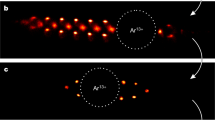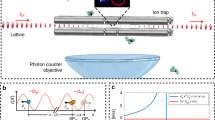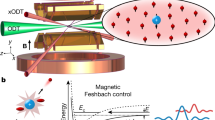Abstract
Studies of interactions between a single pair of atoms in a quantum state are a corner-stone of quantum chemistry, yet the number of demonstrated techniques that enable the observation and control of the outcome of a single collision is still small. Here we demonstrate a technique to study interactions between an ultracold neutral atom and a cold ion using quantum logic. We measure the inelastic release of hyperfine energy in a collision between an ultracold rubidium atom and isotopes of singly ionized strontium that we do not have experimental control over. We detect the collision outcome and measure the inelastic rate of the chemistry ion by reading the motional state of a logic ion qubit in a single shot. Our work extends the toolbox for studying elastic, inelastic and reactive chemical processes with existing experimental tools, especially for atomic and molecular ions for which direct laser cooling and state detection are unavailable.
This is a preview of subscription content, access via your institution
Access options
Access Nature and 54 other Nature Portfolio journals
Get Nature+, our best-value online-access subscription
$29.99 / 30 days
cancel any time
Subscribe to this journal
Receive 12 print issues and online access
$209.00 per year
only $17.42 per issue
Buy this article
- Purchase on Springer Link
- Instant access to full article PDF
Prices may be subject to local taxes which are calculated during checkout



Similar content being viewed by others
Data availability
Source data are provided with this paper. Other data that support the findings of this study are available from the corresponding author on reasonable request.
References
Szabo, A. & Ostlund, N. Modern Quantum Chemistry (Dover, 1996).
Friesner, R. A. Ab initio quantum chemistry: methodology and applications. Proc. Natl Acad. Sci. USA 102, 6648–6653 (2005).
Abrams, D. S. & Lloyd, S. Quantum algorithm providing exponential speed increase for finding eigenvalues and eigenvectors. Phys. Rev. Lett. 83, 5162 (1999).
Chin, C., Grimm, R., Julienne, P. S. & Tiesinga, E. Feshbach resonances in ultracold gases. Rev. Mod. Phys. 82, 1225 (2010).
Paliwal, P. et al. Determining the nature of quantum resonances by probing elastic and reactive scattering in cold collisions. Nat. Chem. 13, 94–98 (2021).
Tomza, M. et al. Cold hybrid ion-atom systems. Rev. Mod. Phys. 91, 035001 (2019).
Meir, Z. et al. Experimental apparatus for overlapping a ground-state cooled ion with ultracold atoms. J. Mod. Opt. 65, 501–519 (2018).
Sikorsky, T., Meir, Z., Ben-shlomi, R., Akerman, N. & Ozeri, R. Spin-controlled atom-ion chemistry. Nat. Commun. 9, 920 (2018).
Sikorsky, T. et al. Phase locking between different partial waves in atom-ion spin-exchange collisions. Phys. Rev. Lett. 121, 173402 (2018).
Major, F. G. & Dehmelt, H. G. Exchange-collision technique for the rf spectroscopy of stored ions. Phys. Rev. 170, 91 (1968).
Feldker, T. et al. Buffer gas cooling of a trapped ion to the quantum regime. Nat. Phys. 16, 413–416 (2020).
Tscherbul, T. V., Brumer, P. & Buchachenko, A. A. Spin-orbit interactions and quantum spin dynamics in cold ion-atom collisions. Phys. Rev. Lett. 117, 143201 (2016).
Ratschbacher, L., Zipkes, C., Sias, C. & Köhl, M. Controlling chemical reactions of a single particle. Nat. Phys. 8, 649–652 (2012).
Rellergert, W. G. et al. Measurement of a large chemical reaction rate between ultracold closed-shell 40Ca atoms and open-shell 174Yb+ ions held in a hybrid atom-ion trap. Phys. Rev. Lett. 107, 243201 (2011).
Ravi, K., Lee, S., Sharma, A., Werth, G. & Rangwala, S. A. Cooling and stabilization by collisions in a mixed ion-atom system. Nat. Commun. 3, 1126 (2012).
Li, H. et al. Photon-mediated charge-exchange reactions between 39K atoms and 40Ca+ ions in a hybrid trap. Phys. Chem. Chem. Phys. 22, 10870–10881 (2020).
Mahdian, A., Krükow, A. & Denschlag, J. H. Direct observation of swap cooling in atom-ion collisions. N. J. Phys. 23, 065008 (2021).
Ben-shlomi, R. et al. High-energy-resolution measurements of an ultracold-atom-ion collisional cross section. Phys. Rev. A 103, 032805 (2021).
Hall, F. H. J., Aymar, M., Bouloufa-Maafa, N., Dulieu, O. & Willitsch, S. Light-assisted ion-neutral reactive processes in the cold regime: radiative molecule formation versus charge exchange. Phys. Rev. Lett. 107, 243202 (2011).
Mohammadi, A. et al. Life and death of a cold BaRb+ molecule inside an ultracold cloud of Rb atoms. Phys. Rev. Res. 3, 013196 (2021).
Haze, S., Sasakawa, M., Saito, R., Nakai, R. & Mukaiyama, T. Cooling dynamics of a single trapped ion via elastic collisions with small-mass atoms. Phys. Rev. Lett. 120, 043401 (2018).
Zipkes, C., Palzer, S., Ratschbacher, L., Sias, C. & Köhl, M. Cold heteronuclear ‘atom-ion collisions’. Phys. Rev. Lett. 105, 133201 (2010).
Schmidt, P. O. et al. Spectroscopy using quantum logic. Science 309, 749–752 (2005).
Wolf, F. et al. Non-destructive state detection for quantum logic spectroscopy of molecular ions. Nature 530, 457–460 (2016).
Sinhal, M., Meir, Z., Najafian, K., Hegi, G. & Willitsch, S. Quantum-nondemolition state detection and spectroscopy of single trapped molecules. Science 367, 1213–1218 (2020).
Lin, Y., Leibrandt, D. R., Leibfried, D. & Chou, C. Quantum entanglement between an atom and a molecule. Nature 581, 273–277 (2020).
Chou, C. W. et al. Frequency-comb spectroscopy on pure quantum states of a single molecular ion. Science 367, 1458–1461 (2020).
Brewer, S. M. et al. 27Al+ quantum-logic clock with a systematic uncertainty below 10−18. Phys. Rev. Lett. 123, 033201 (2019).
Gebert, F. et al. Precision isotope shift measurements in calcium ions using quantum logic detection schemes. Phys. Rev. Lett. 115, 053003 (2015).
Kienzler, D. et al. Quantum logic spectroscopy with ions in thermal motion. Phys. Rev. X 10, 021012 (2020).
Micke, P. et al. Coherent laser spectroscopy of highly charged ions using quantum logic. Nature 578, 60–65 (2020).
Wan, Y. et al. Precision spectroscopy by photon-recoil signal amplification. Nat. Commun. 5, 3096 (2014).
Gebert, F. et al. Precision isotope shift measurements in calcium ions using quantum logic detection schemes. Phys. Rev. Lett. 115, 053003 (2015).
Hall, F. H. J. & Willitsch, S. Millikelvin reactive collisions between sympathetically cooled molecular ions and laser-cooled atoms in an ion-atom hybrid trap. Phys. Rev. Lett. 109, 233202 (2012).
Najafian, K., Meir, Z., Sinhal, M. & Willitsch, S. Identification of molecular quantum states using phase-sensitive forces. Nat. Commun. 11, 4470 (2020).
Meir, Z., Hegi, G., Najafian, K., Sinhala, M. & Willitsch, S. State-selective coherent motional excitation as a new approach for the manipulation, spectroscopy and state-to-state chemistry of single molecular ions. Faraday Discuss. 217, 561–583 (2019).
Tomza, M. & Lisaj, M. Interactions and charge-transfer dynamics of an Al+ ion immersed in ultracold Rb and Sr atoms. Phys. Rev. A 101, 012705 (2020).
Cetina, M., Grier, A. T. & Vuletić, V. Micromotion-induced limit to atom-ion sympathetic cooling in Paul traps. Phys. Rev. Lett. 109, 253201 (2012).
Côté, R. Ultracold hybrid atom-ion systems. Adv. Atom. Molec. Opt. Phys. 65, 67–126 (2016).
Wesenberg, J. H. et al. Fluorescence during Doppler cooling of a single trapped atom. Phys. Rev. A 76, 053416 (2007).
Drewsen, M., Mortensen, A., Martinussen, R., Staanum, P. & Sørensen, J. L. Nondestructive identification of cold and extremely localized single molecular ions. Phys. Rev. Lett. 93, 243201 (2004).
Pinkas, M. et al. Effect of ion-trap parameters on energy distributions of ultra-cold atom-ion mixtures. N. J. Phys. 22, 013047 (2020).
Côté, R. & Simbotin, I. Signature of the s -wave regime high above ultralow temperatures. Phys. Rev. Lett. 121, 173401 (2018).
Tomza, M., Koch, C. P. & Moszynski, R. Cold interactions between an Yb+ ion and a Li atom: prospects for sympathetic cooling, radiative association, and Feshbach resonances. Phys. Rev. A 91, 042706 (2015).
Weckesser, P. et al. Observation of Feshbach resonances between a single ion and ultracold atoms. Preprint at https://arxiv.org/abs/2105.09382 (2021).
Bermudez, A., Schindler, P., Monz, T., Blatt, R. & Müller, M. Micromotion-enabled improvement of quantum logic gates with trapped ions. N. J. Phys. 19, 113038 (2017).
Zipkes, C., Ratschbacher, L., Sias, C. & Köhl, M. Kinetics of a single trapped ion in an ultracold buffer gas. N. J. Phys. 13, 053020 (2011).
Berkeland, D. J., Miller, J. D., Bergquist, J. C., Itano, W. M. & Wineland, D. J. Minimization of ion micromotion in a Paul trap. J. Appl. Phys. 83, 5025 (1998).
Wübbena, J. B., Amairi, S., Mandel, O. & Schmidt, P. O. Sympathetic cooling of mixed-species two-ion crystals for precision spectroscopy. Phys. Rev. A 85, 043412 (2012).
Acknowledgements
We thank Z. Meir for useful comments on the manuscript. This work was supported by the Israeli Science Foundation, the Israeli Ministry of Science, Technology and Space and the Minerva Stiftung.
Author information
Authors and Affiliations
Contributions
O.K., M.P., N.A. and R.O. contributed to the experimental design, construction, discussions and wrote the manuscript. O.K. collected the data and analysed the results. O.K. claims responsibility for all figures.
Corresponding author
Ethics declarations
Competing interests
The authors declare no competing interests.
Peer review
Peer review information
Nature Physics thanks the anonymous reviewers for their contribution to the peer review of this work.
Additional information
Publisher’s note Springer Nature remains neutral with regard to jurisdictional claims in published maps and institutional affiliations.
Extended data
Extended Data Fig. 1 Detection efficiency of electron shelving technique and its extension to additional configurations.
(a) The probability P(1) to measure the ion in the S, electronic ground-state, (bright) after a single shelving π-pulse of duration Tπ, following a single exothermic process releasing a total energy ΔE. For energetic processes (ΔE ≫ η2ℏω1z) and low beam power (ωz1Tπ ≳ 1) the detection of hot events approaches unity. Variation of the pulse duration Tπ implies simultaneous change of the Rabi frequency and pulse duration. (b) Detection efficiency of two pulses of electron shelving in the low beam power limit with the experimental parameters. A tilted beam (red) features sharper detection curve with respect to a beam co-linear with the trap axis (blue, denoted as the ‘base configuration’ in this analysis) that is sensitive to motion only along that axis. Black arrow marks the energy of hyperfine-changing collision studied in the experimental realization. (c)-(e) Extensions of the base configuration. (c) Variation of the the axial trap frequency enables detection of exothermic processes releasing energy below kB × (1 mK) at standard trap frequencies. (d) Configurations with unbalanced masses change the detection probability for exothermic process via scaling of the parameters ξz1, ξz2 [c.f. Eq. (5)-(6))]. Top: variation of the atom to chemistry-ion mass ratio for a fixed \({m}_{{{{\rm{i}}}}}^{L}={m}_{{{{\rm{i}}}}}^{c}\). Bottom: variation of the chemistry-ion to logic-ion mass ratio for a fixed \({m}_{{{{\rm{i}}}}}^{L}\) and \({m}_{{{{\rm{a}}}}}={m}_{{{{\rm{i}}}}}^{L}\). (e). Detection of elastic and endothermic collisional processes. An atom with kinetic energy Ea and moving perpendicular to the beam direction can scatter and generate motion of the crystal along the axis detected by the shelving beam (light-blue curve) in the base configuration. An endothermic process which converts a kinetic energy ΔE into internal one can be detected efficiently by varying the kinetic energy of the atom near Ea = 2∣ΔE∣ (brown curve). Data in (a)-(e) is calculated numerically.
Supplementary information
Supplementary Information
Supplementary Notes 1 and 2 and Fig. 1.
Source data
Source Data Fig. 2
Data for Fig. 2d.
Source Data Fig. 3
Data for Fig. 3.
Source Data Extended Data Fig. 1
Data for Extended Data Fig. 1.
Rights and permissions
About this article
Cite this article
Katz, O., Pinkas, M., Akerman, N. et al. Quantum logic detection of collisions between single atom–ion pairs. Nat. Phys. 18, 533–537 (2022). https://doi.org/10.1038/s41567-022-01517-y
Received:
Accepted:
Published:
Issue Date:
DOI: https://doi.org/10.1038/s41567-022-01517-y
This article is cited by
-
Trap-assisted formation of atom–ion bound states
Nature Physics (2023)
-
Collision detection with logic
Nature Physics (2022)



